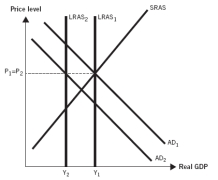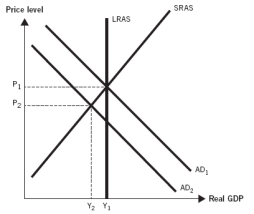A) the economy can become stuck at high levels of unemployment for long periods of time.
B) the economy is self-correcting in response to shocks.
C) the government will need to intervene in the economy frequently.
D) the best type of economy is centrally planned and run by the state.
E) the economy will experience wild swings in output and employment.
Correct Answer

verified
Correct Answer
verified
Multiple Choice
During the Great Depression, the U.S. aggregate demand curve shifted to the left, in part, because:
A) the U.S. government increased the money supply.
B) stock prices increased dramatically.
C) the U.S. government increased taxes.
D) there was a gradual decline in the U.S. population.
E) more Americans attended college than in the past.
Correct Answer

verified
Correct Answer
verified
Multiple Choice
One of the reasons why the Great Depression was so severe is that:
A) the U.S. government lowered taxes.
B) stock prices increased during the Great Depression.
C) expected income increased.
D) the U.S. government allowed the money supply to decline.
E) the U.S. government allowed the money supply to increase.
Correct Answer

verified
Correct Answer
verified
Multiple Choice
The Great Depression actually consisted of two separate recessions. The "second wave" of the Great Depression began in _________ and lasted for _________.
A) August 1929; 44 months
B) March 2001; 8 months
C) December 2007; 18 months
D) May 1937; 14 months
E) December 1974; 16 months
Correct Answer

verified
Correct Answer
verified
Multiple Choice
A decline in U.S. wealth would tend to cause:
A) long-run aggregate supply to increase.
B) aggregate demand to decrease.
C) short-run aggregate supply to increase.
D) long-run aggregate supply to decrease.
E) aggregate demand to increase.
Correct Answer

verified
Correct Answer
verified
Multiple Choice
Which of the following policy statements would a classical economist tend to support?
A) The government should be prepared to intervene when aggregate demand changes in any way.
B) The government should only intervene in the economy when aggregate demand decreases.
C) The government should allow the economy to adjust to changes in aggregate demand on its own, without interference.
D) The government should frequently change taxes and spending levels to manipulate the economy.
E) The government should only intervene in the economy when aggregate demand increases.
Correct Answer

verified
Correct Answer
verified
Multiple Choice
When considering how the economy works, classical economists hold that:
A) prices are sticky.
B) savings is a drain on demand.
C) the market tends toward instability and cyclical unemployment.
D) the long run is more significant than the short run.
E) the economy needs help in moving back to full employment.
Correct Answer

verified
Correct Answer
verified
Multiple Choice
During the Great Recession, U.S. household wealth declined, leading to a decrease in aggregate demand. Which pair of factors contributed to this decline in wealth?
A) an increase in tax rates and a decrease in stock prices
B) a decrease in stock prices and a decrease in housing prices
C) a decrease in housing prices and a decline in the level of technology
D) a financial-market crisis and an increase in gas prices
E) a decrease in housing prices and a decrease in the money supply
Correct Answer

verified
Correct Answer
verified
Multiple Choice
During the Great Recession, a major financial crisis followed the collapse of housing prices, which led to:
A) a decrease in the money supply by the Federal Reserve.
B) the decline in the health of many large financial firms and banks.
C) skyrocketing oil prices.
D) an increase in income tax rates to shrink the federal budget deficit.
E) an increase in expected income.
Correct Answer

verified
Correct Answer
verified
Multiple Choice
Use the following graph to answer the next questions. The graph depicts an economy where aggregate demand and long-run aggregate supply (LRAS) have decreased, with no change in short-run aggregate supply (SRAS) .  -The decline in housing prices contributed to the Great Recession, as depicted in the graph, in that:
-The decline in housing prices contributed to the Great Recession, as depicted in the graph, in that:
A) it caused real gross domestic product (GDP) and the price level to increase.
B) it caused an increase in oil and gas prices, which led to inflation.
C) it caused a decrease in household wealth and created a crisis in the loanable funds market.
D) it caused an increase in household wealth and a crisis in the loanable funds market.
E) it prevented unemployment from rising above historical averages.
Correct Answer

verified
Correct Answer
verified
Multiple Choice
The Great Recession is characterized by a decrease in aggregate demand. __________ would have caused such a decrease.
A) A decrease in consumer sentiment
B) A decrease in income tax rates
C) An increase in international trade
D) An increase in expected income
E) An increase in immigration to the United States
Correct Answer

verified
Correct Answer
verified
Multiple Choice
Use the following graph to answer the next questions. This graph depicts an economy where aggregate demand has decreased, with no change in either short-run aggregate supply (SRAS) or long-run aggregate supply (LRAS) .  -During the Great Depression, the aggregate price level and real gross domestic product (GDP) both decreased, as depicted in the graph. Unemployment increased to record levels. Which of following best explains why this happened?
-During the Great Depression, the aggregate price level and real gross domestic product (GDP) both decreased, as depicted in the graph. Unemployment increased to record levels. Which of following best explains why this happened?
A) A sudden increase in oil prices caused inflation and a deep recession.
B) A stock market crash, large numbers of bank failures, an increase in tax rates, and a tight money supply caused a recession.
C) A rapid decline in housing prices led to problems in the loanable funds market and a recession.
D) A significant decline in military spending following the end of a war led to a recession.
E) A sharp recession followed the United States abandoning the gold standard.
Correct Answer

verified
Correct Answer
verified
Multiple Choice
Which of the following policy statements would a Keynesian economist tend to support?
A) The government should encourage savings as a means of promoting economic growth.
B) The government should never intervene in the economy.
C) The government should intervene in the economy to promote full employment.
D) The government should intervene in the economy only when aggregate supply changes.
E) The government should focus on long-run aggregate supply, not aggregate demand.
Correct Answer

verified
Correct Answer
verified
Multiple Choice
The Great Recession lasted longer and was deeper than the average recession, in part, because:
A) oil-producing countries dramatically increased oil prices, causing very high inflation.
B) there was a dramatic cut in military spending in the years leading up to the recession.
C) the Federal Reserve refused to increase the money supply to stimulate aggregate demand.
D) the government raised tax rates in an effort to balance the federal budget.
E) there was a major financial crisis following the collapse of housing prices.
Correct Answer

verified
Correct Answer
verified
Multiple Choice
Keynesian economists believe that savings is a drain on demand because:
A) when a recession occurs, households tend to spend less, which only worsens the recession.
B) prices are flexible and allow the economy to quickly return to full employment.
C) the economy is stable and tends toward full employment.
D) government intervention in the economy is unnecessary.
E) the short run is more important than the long run, and economic policy only works in the short run.
Correct Answer

verified
Correct Answer
verified
Multiple Choice
The Great Recession lasted for:
A) 12 months.
B) 18 months.
C) 32 months.
D) 44 months.
E) 56 months.
Correct Answer

verified
Correct Answer
verified
Multiple Choice
Use the following graph to answer the next questions. The graph depicts an economy where aggregate demand and long-run aggregate supply (LRAS) have decreased, with no change in short-run aggregate supply (SRAS) .  -In the graph, we see that long-run aggregate supply decreased during the Great Recession. This was due to a decline in housing prices and the subsequent financial crisis. Why did these factors cause long-run aggregate supply to decrease?
-In the graph, we see that long-run aggregate supply decreased during the Great Recession. This was due to a decline in housing prices and the subsequent financial crisis. Why did these factors cause long-run aggregate supply to decrease?
A) They caused household wealth and expected income to decline.
B) They caused permanent changes in the market for loanable funds.
C) They caused oil and gas prices to increase, causing inflation.
D) They caused unemployment to remain at normal levels.
E) They caused deflation and an increase in the value of the dollar.
Correct Answer

verified
Correct Answer
verified
Multiple Choice
The Great Depression is characterized by a decrease in aggregate demand. Of the following factors, which would have caused aggregate demand to decrease?
A) an increase in the labor supply
B) an increase in the money supply
C) an advance in technology
D) a decrease in expected future income
E) an increase in government spending
Correct Answer

verified
Correct Answer
verified
Multiple Choice
When describing how the economy works, classical economists claim that:
A) the economy needs help in moving back to full employment.
B) savings is a drain on demand.
C) aggregate demand is more significant than aggregate supply.
D) savings is crucial to economic growth.
E) prices are sticky.
Correct Answer

verified
Correct Answer
verified
Multiple Choice
During the Great Recession, the U.S. ________ curve shifted to the ________.
A) aggregate demand; right
B) short-run aggregate supply; right
C) long-run aggregate supply; right
D) aggregate demand; left
E) production possibilities; right
Correct Answer

verified
Correct Answer
verified
Showing 61 - 80 of 142
Related Exams